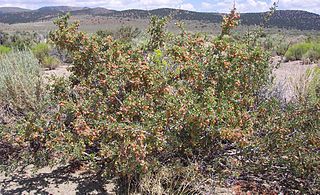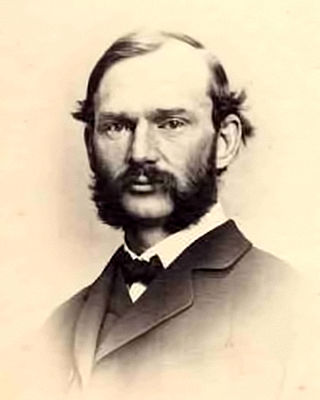
Quercus wislizeni, known by the common name interior live oak, is an evergreen oak, highly variable and often shrubby, found in many areas of California in the United States continuing south into northern Baja California in Mexico. It generally occurs in foothills, being most abundant in the lower elevations of the Sierra Nevada, but also widespread in the Pacific Coast Ranges—where since 1980 it has been known as a separate species Quercus parvula—and the San Gabriel Mountains. It was named for its collector, Friedrich Adolph Wislizenus (1810–1889).

Birbal Sahni FRS was an Indian paleobotanist who studied the fossils of the Indian subcontinent. He also took an interest in geology and archaeology. He founded what is now the Birbal Sahni Institute of Palaeobotany at Lucknow in 1946. His major contributions were in the study of the fossil plants of India and in plant evolution. He was also involved in the establishment of Indian science education and served as the president of the National Academy of Sciences, India and as an honorary president of the International Botanical Congress, Stockholm.

Prunus andersonii is a species of shrub in the rose family, part of the same genus as the peach, cherry, and almond. Its common names include desert peach and desert almond. It is native to eastern California and western Nevada, where it grows in forests and scrub in desert and mountains. It was named after Charles Lewis Anderson by Asa Gray.

William Gilson Farlow was an American botanist, born in Boston, Massachusetts, and educated at Harvard, where, after several years of European study, he became adjunct professor of botany in 1874 and professor of cryptogamic botany in 1879.
Joseph Whipple Congdon was a lawyer by trade who contributed significantly to early botanical exploration in California, particularly in the Yosemite region, where he resided in Mariposa from 1882 until 1905. Congdon was born in Pomfret, Connecticut and graduated Brown University with the class of 1855. He was admitted to the bar in Providence, Rhode Island in 1860. He served a term in the Rhode Island legislature for 1878–79. The "Analytical Class-Book of Botany", coauthored with his aunt, [carrying the epigram "Science is the only interpreter of Nature"] antedated by two years the first edition of Class Book of Botany, by Asa Gray. Congdon was the botanist whom correctly diagnosed the rediscovery of the long-lost Shortia galacifolia, a relict herb that had been long sought by Gray.

Arctostaphylos andersonii, the Santa Cruz manzanita, is a species of Arctostaphylos.

Lepidospartum is a genus of North American desert shrubs in the daisy family. They are known commonly as broomsages or scalebrooms. These are tall, woody shrubs with stiff twiggy branches that resemble brooms. They are native to the southwestern United States and far northern Mexico. These shrub have thin, narrow, needlelike or scalelike leaves and bear yellow daisy flowers.

Delphinium andersonii is a species of perennial larkspur known as Anderson's larkspur. This wildflower is native to western North America, where it can be found in the Great Basin and the Sierra Nevada.

Lycium andersonii is a species of flowering plant in the nightshade family, Solanaceae. Its common names include water-jacket, redberry desert-thorn, Anderson thornbush, Anderson's desert thorn, Anderson boxthorn, Anderson lycium, Anderson wolfberry, and squawberry.

Geraea is a genus of the family Asteraceae from the southwestern United States and northwestern Mexico, commonly called the desert sunflower.

Astragalus andersonii is a species of milkvetch known by the common name Anderson's milkvetch. It is native to eastern California and western Nevada, where it is found in the plateaus at the foot of the Sierra Nevada, including the Modoc Plateau. It was named after Charles Lewis Anderson by Asa Gray.

Cirsium andersonii is a North American species of thistle known by the common names Anderson's thistle and rose thistle. It is native to California, Oregon, and Nevada, where it grows in the woodlands and forest openings of the local high mountain ranges, including the Sierra Nevada and the southern Cascade Range. It has also been reported from Idaho.

Crepis occidentalis is a North American species of flowering plant in the family Asteraceae known by the common names western hawksbeard, or largeflower hawksbeard. It is native to western Canada and the western United States.

Earl Lemley Core was a botanist and botanical educator, researcher, and author as well as a local West Virginia historian. He was founder of the Southern Appalachian Botanical Club and editor of its journal, Castanea, for thirty-five years. He was a teacher and professor at West Virginia University (WVU) from 1928 to 1972. He served for four years on the Morgantown City Council, and served as mayor of Morgantown for two years. The Earl L. Core Arboretum at WVU was named in his honor in 1967.

Daniel Cady Eaton was an American botanist and author. After studies at the Rensselaer Institute in Troy and Russell's military school in New Haven, he gained his bachelor's degree at Yale College, then went on to Harvard University, where he studied with Asa Gray. He then went to Yale University's Sheffield Scientific School in 1864, where he was a botany professor and herbarium curator. With William Gilson Farlow and Charles Lewis Anderson he issued the exsiccata series Algae exsiccatae Americae Borealis (1877-1889). Eaton is the grandson of Amos Eaton.

Ranunculus andersonii is a species of buttercup known by the common name Anderson's buttercup. It is native to the western United States, including the Great Basin and surrounding regions, where it grows in sagebrush, woodlands, and other habitat. It is a perennial herb producing a basal rosette of thick leaves which are each divided into three double-lobed leaflets at the end of a petiole. The inflorescence arises from the rosette on an erect, leafless stalk usually no more than 20 centimeters tall. It bears one flower with usually five white or red-tinged petals each up to 2 centimeters long with white or pinkish sepals at the base. At the center of the flower are many yellow stamens and pistils. The fruit is an achene, borne in a spherical cluster of 14 or more. It was named after Charles Lewis Anderson by Asa Gray.
Trifolium andersonii is a species of clover known by the common names fiveleaf clover and Anderson's clover. It is native to the western United States, particularly the Great Basin and adjacent high mountain ranges, including the Sierra Nevada. It was named after Charles Lewis Anderson by Asa Gray.

Jesse More Greenman was an American botanist. He specialized in tropical flora, with emphasis on plants from Mexico and Central America. He was an authority on the genus Senecio and noted for his work at the Missouri Botanical Garden.

Volney Rattan was an American botanist who spent most of his professional life in California. He botanized in remote and wild areas of northwest California, finding many species new to science. He corresponded with eminent botanists Asa Gray and George Engelmann, and sent specimens to them. He was an inspiring teacher, and wrote books to help those with botanical interests to learn principles of taxonomy, and to help them identify native plants of California. Many plant species have been named after him.

Agatea is a genus of flowering plants in the violet family Violaceae, with seven accepted species, found in New Guinea and New Caledonia.





















